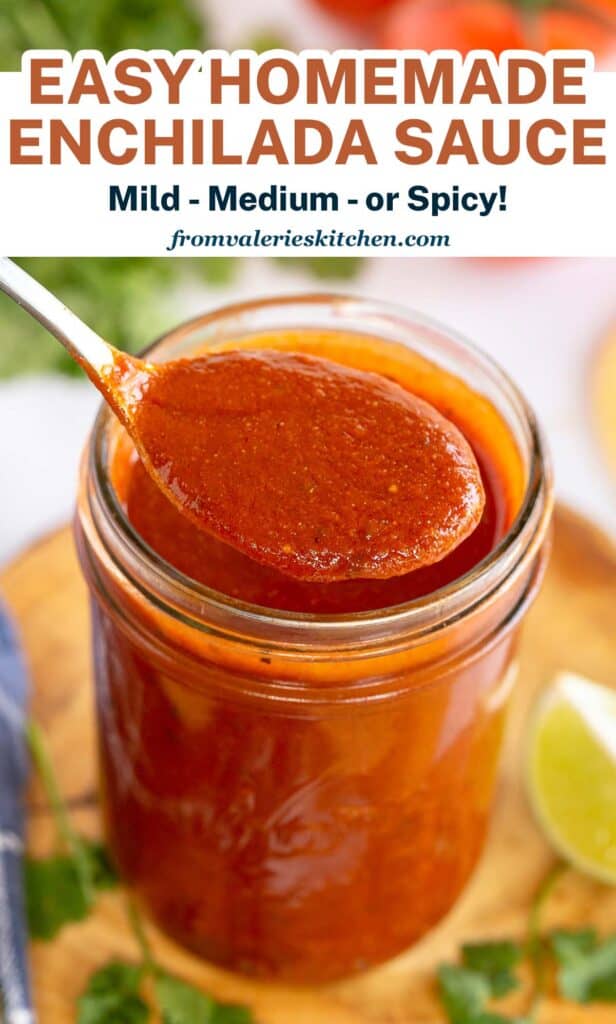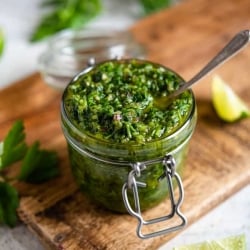This homemade Red Enchilada Sauce recipe is fresh, flavorful, and so much better than canned sauce. It takes just minutes to make and can be made as mild or spicy as you’d like!
I use this sauce in any recipe that calls for red enchilada sauce, like my Shredded Beef Enchiladas.

With the amount of Mexican food consumed around these parts, it’s pretty vital for me to have a top notch enchilada sauce recipe at my disposal. This recipe makes a classic red enchilada sauce or a smoky red sauce for a delicious variation. Instead of opening a can, whip up this easy Red Enchilada Sauce in minutes to elevate your Mexican and Tex-Mex recipes.
Why You’ll Love this Recipe
- The simple ingredient list includes easy to stock pantry staples. In fact, you may have everything you need in your kitchen to make it now!
- A seriously delicious blend of seasonings make it stand out from other recipes.
- It takes 10 minutes to make from start to finish.
- You can make it in advance and freeze it for easy future meals.

Ingredient Notes

- Oil – Use a neutral oil like canola or vegetable oil.
- All purpose flour
- Seasoning – A blend of dried seasonings is what truly makes this recipe shine. Chili powder, cumin, paprika, onion powder, garlic powder, oregano, and coriander.
- Low sodium broth – Beef for a “beefier” flavor, chicken, or vegetable broth for a vegetarian enchilada sauce. It’s delicious with any type of broth but I tend to go with beef broth if I’m using the sauce for beef enchiladas and chicken broth for chicken enchiladas.
- Tomato sauce
- Salt and freshly ground black pepper
- Cayenne pepper – Optional to make this a medium to spicy enchilada sauce.
For classic enchilada sauce use sweet paprika or substitute smoked paprika for a smoky enchilada sauce that’s delicious in Mexican or Southwest recipes.
How to Make Red Enchilada Sauce

- Add the oil to a large saucepan and place it over medium heat. Whisk in the flour to create a roux and cook for 1 minute.
- Reduce the heat under the pan, add the spices, and cook, whisking occasionally, for about 30 seconds.
- Whisk in the broth a little at a time and then add the tomato sauce.
- Whisk the enchilada sauce until it’s smooth and thickened. Bring it to a simmer and then reduce the heat and simmer for 5 minutes to intensify the flavor. Season with salt and pepper, to taste.
Controlling the Spice Level
- Mild Enchilada Sauce – Be sure you are using a mild, light chili powder like McCormick Chili Powder which adds robust flavor but almost no heat at all. Omit the optional cayenne pepper for a very mild red sauce.
- Medium Enchilada Sauce – Add ¼ to ½ teaspoon cayenne pepper for a moderately spicy enchilada sauce.
- Spicy Enchilada Sauce – Increase the amount of cayenne pepper to make it as spicy as you’d like.

Using the Sauce to Make Enchiladas
This recipe yields just shy of 4 cups of Red Enchilada Sauce. This is the perfect amount for two 13- x 9-inch baking dishes full of enchiladas like my Shredded Beef Enchiladas or Easy Slow Cooker Chicken Enchiladas. Just spread 1 cup of sauce on the bottom of the baking dish, add your enchiladas, and spoon 1 cup of sauce over the top. Top the enchiladas with cheese and bake them as directed in your recipe. If you don’t want to make a second batch of enchiladas you can freeze the remainder of the sauce for a future meal. See below for storage tips.

Ways to Use Enchilada Sauce
Enchilada sauce goes beyond enchiladas! You can use this enchilada sauce to make smothered burritos, nachos, soups, and dips. These are my favorite ways to make use of homemade enchilada sauce.
- Smothered burritos – Spoon red enchilada sauce over the top of your favorite burrito recipe, sprinkle them with shredded cheese and cook in the oven or microwave until the cheese melts.
- Nachos – Drizzle a little enchilada sauce over the top for revved up, super flavorful nachos.
- Chicken Tamale Casserole
- Slow Cooker Chicken Enchilada Dip
- Tex-Mex Turkey Soup
- Beef Enchilada Dip

Storage Tips
Refrigerate homemade enchilada sauce for up to 4 days or freeze in a freezer-safe container for up to 3 months. Allow frozen enchilada sauce to thaw in the refrigerator overnight before using.
I recommend storing acidic, tomato based sauces in glass containers or zippered plastic storage bags since they may transfer color to plastic storage containers. I like to use mason jars which have tight fitting lids and are also freezer-safe. Plastic storage bags can be stacked flat after they are frozen which is a great space saver.

Easy Red Enchilada Sauce
Ingredients
- 3 tablespoons canola or vegetable oil
- 2 tablespoons all-purpose flour
- 2 tablespoons chili powder
- 1 ½ teaspoons cumin
- 1 teaspoons paprika, sweet or smoked (see notes below)
- 1 teaspoon onion powder
- 1 teaspoon garlic powder
- ½ teaspoon dried oregano
- ½ teaspoon dried coriander
- 2 cups low sodium broth, beef, chicken, or vegetable
- 15 ounce can tomato sauce
- ⅛ teaspoon salt, or to taste
- ⅛ teaspoon freshly ground black pepper, or to taste
- cayenne pepper, optional and to taste (see notes below)
Instructions
- Add the oil to a large saucepan and place over medium heat. Whisk in the flour and cook for 1 minute. Reduce heat to LOW, add the spices and cook, whisking occasionally, for 30 seconds. Whisk in the broth a little at a time and then add the tomato sauce and whisk until smooth and thickened.
- Bring to a simmer and then reduce heat to LOW and simmer for 5 minutes to intensify the flavor. Add salt and pepper, to taste.
Notes
- Mild Enchilada Sauce – Be sure you are using a mild, light chili powder like McCormick Chili Powder which adds robust flavor but almost no heat at all. Omit the optional cayenne pepper for a very mild red sauce.
- Medium Enchilada Sauce – Add ¼ to ½ teaspoon cayenne pepper for a moderately spicy enchilada sauce.
- Spicy Enchilada Sauce – Increase the amount of cayenne pepper to make it as spicy as you’d like.
Nutrition
Nutrition information is automatically calculated using generic ingredients, and is an estimate not a guarantee. For more accurate results, please refer to the labels on your ingredients at home.






















Could I use olive oil instead of the vegetable oil or canola?
Hi Gail. You can, but I use a neutral oil that won’t add any flavor to the sauce the way olive oil might.